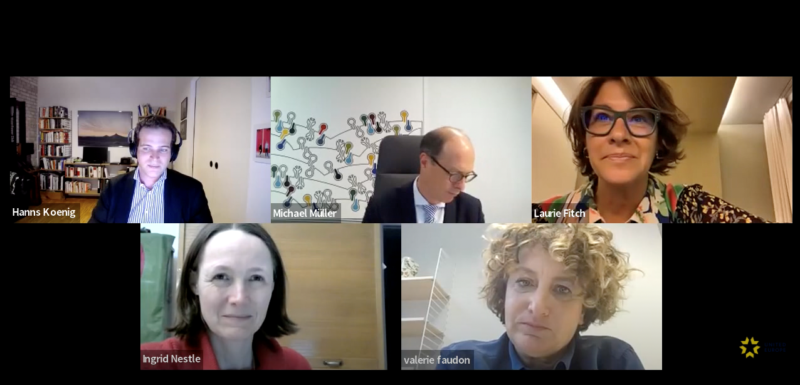Our virtual Advocacy Webinar in partnership with Aurora Energy Research took place on 24th February via Zoom. We were joined by an all-star panel with Michael Müller (CFO of RWE), Valerie Faudon (DG of SFEN – Societe Francaise d’Energie Nucleaire), Laurie Fitch (Partner at PJT Partners), and Ingrid Nestle (MP and energy/climate spokesperson at Bündnis90/Die Grünen) to discuss whether natural gas and nuclear should count as “green” under the new EU Taxonomy for sustainable activities. The panel was moderated by United Europe’s longtime member and Advocate Hanns Koenig, Head of Commissioned Projects, Central Europe at Aurora Energy Research.
Please find the recording of the webinar on our YouTube channel.
Summary:
The EU taxonomy is a classification aimed at helping financial markets define what is green or what is not
green, so as to avoid greenwashing and accelerate green investments. The EC proposed to include
nuclear and natural gas into the taxonomy, subject to them fulfilling certain criteria. Although the proposal
was highly controversial, the EC decided to move forward, hoping the two sectors can help the bloc meet
its ambitious roadmap to climate neutrality. Coincidentally, Russia invaded Ukraine on the same day of the
webinar, which in the meantime has pushed up natural gas prices significantly and resulted in a push in
Europe to reduce reliance on Russian gas. This may result in a strong move towards a financially viable
option of “green” hydrogen, as well as other alternatives to natural gas, over the long term, reducing at
least the impact of including natural gas in the taxonomy.
Key Conclusions:
Michael Müller (RWE) suggested that whether a company’s activities are “green” should be judged by
how it spends its CAPEX, rather than its legacy activities, because CAPEX clearly demonstrates how
much investment is put into new technologies. The automotive, chemical, and steel industries face huge
investment needs. Looking at the status quo alone will not help transform energy markets.
Although the Green Party has been traditionally against gas, Ingrid Nestle (Bündnis90/The Greens) sees
the need in providing energy security through gas-fired power plants. She took a strong stand against
nuclear, and pointed to the still unresolved issue of nuclear waste management and to delays in the buildup of new nuclear power plants in Western Europe: “They are a decade late and it doesn’t take a decade to build them. They are one decade behind schedule.” Nuclear Power is much more expensive than renewable power and Europe should not spend more money, time, and political energy on nuclear, but instead focus on green infrastructure, Ingrid Nestle concluded.
Valerie Faudon (SFEN) from the French Nuclear Association, countered that nuclear is necessary for
energy security and that nuclear forms an important part of the energy transformation process: It is a
question of Europe’s competitiveness, Valerie said. Europe needs to take an international perspective:
reducing emissions is a global issue and nuclear will be part of other taxonomies, for example in the US or
Canada.
Laurie Fitch (PJT) highlighted the urgency of energy security. The power sector is not an industry where
supply chain failures can be blamed on blackouts. It is essential, she said: “Given the sheer sums of
money and time horizons involved in investing in green infrastructure, it has to be very clearly classified.
Therefore the taxonomy is highly important and really matters to capital flows.” Consequently, the
taxonomy underpins a much wider definition of what might be considered sustainable. There’s a five
hundred billion per annum fast-growing green bond market, and capital flows will definitely pay attention to the taxonomy.
Full Interview (edited):
HK: RWE is investing in power generation assets across Europe. How does the taxonomy affect large
power generators?
Michael Müller, RWE
The taxonomy provides a classification for activities that are sustainable and supports investors or the
capital market to make decisions on where to invest. It provides a classification and in principle, this is a good approach: But in practice, it is an administrative burden in particular to large power generators. The
taxonomy criteria are based on sustainable and non-sustainable activity, which is a totally different
perspective to be documented and it takes huge effort to provide the reporting.
HK: The German Green Party has been traditionally quite critical of including gas and nuclear in
the taxonomy. Now the Green Party is in government in Germany, and supported a compromise
that included natural gas and nuclear as “green” – why?
Ingrid Nestle, Bündnis90/TheGreens: The taxonomy is a good approach but the inclusion of both
nuclear and gas makes it less credible. Nuclear is definitely treated too well and it is a huge mistake to
include it. A technology that delivers waste to be guarded for ten thousand years cannot be sustainable.
Natural gas is another story: here, one has to differentiate between fossil gas and gas-fired power plants,
which can run with different types of gas including hydrogen in the future. These power plants are not only
acceptable, but they are also necessary for the 100 percent renewable future.
HK: Is nuclear treated fairly in the taxonomy or are the restrictions in place too strong?
Valerie Faudon, SFEN, Nuclear is one of the lowest emission sources in France. Waste management is heavily regulated and controlled in Europe. There is for example a deep geological storage solution to store nuclear waste where it is not in contact with the biosphere. In the taxonomy, nuclear is classified in the “transition” category. Hence, technical conditions have to be revised every four years. This is difficult because nuclear plants are set to operate for 60 years. Even with renewables, Europe relies on nuclear power due to its ability to be stored and scaled. The current 2050 scenario of the European Commission includes that nuclear will produce 15% of electricity in Europe in 2050.
HK: Does the taxonomy matter in shifting capital flows, or are we attributing too much impact to
the discussion over the past month? Has that been overblown?
Laurie Fitch, PJT Partners: Sustainability really matters when it comes to capital flows. The taxonomy
underpins a much wider definition of what might be considered sustainable. If you look at the capital flows, there’s a five hundred billion per annum fast-growing green bond market, and capital flows will ultimately pay attention to the taxonomy.
HK: The taxonomy means micromanagement and administrative burden for energy generators.
Would it not be more sensible to get rid of it altogether and let market forces and ETS run their
course? We can get rid of the taxonomy or the micromanagement altogether. Would that not have
been a more sensible approach?
MM, RWE: The taxonomy could be more pragmatic but introducing classification is clearly helpful. To
make investments green, there needs to be some kind of green classification. For industry, it is very
important that the taxonomy looks at two different criteria: firstly, how much of your revenues are
sustainable and how much are not sustainable, and secondly CAPEX, the sustainability of investments.
That is a very important difference. RWE has a heavy legacy coal portfolio but also a clear commitment to
transform that portfolio into a renewables portfolio. This is the transition that needs financing. We are
strongly pushing for the taxonomy to look at CAPEX because it is clearly demonstrating how much
investment is put into new technologies and how much speed you really put into transition. The
automotive, chemical, and steel industries have huge costs ahead of them and that needs funding.
Looking at the status quo doesn’t help the energy transformation.
Ingrid Nestle: The current proposal is in the hand of the parliament and this is what we have to work with.
In regards to nuclear, I heartily disagree that we know how to deal with waste. They are very strict
regulations because it’s so extremely difficult to deal with. We still don’t have a solution, but also nuclear
will simply be too late and too expensive. In my opinion, it’s kind of a hoax. All three new nuclear power
plants that are being built in Western Europe are a decade late. It doesn’t take a decade to build them.
They are one decade behind schedule. And there’s so much more expensive than renewables that are just
tearing away money, time, and political energy.
We now need to start talking about green infrastructure. How do we make sure that existing gas networks
or converted gas networks are available for hydrogen? We have to get electrolysis up and running so that
we get to a hydrogen economy. We are talking about 15 years. That sounds a lot. But I give you an
example: the biggest electrolyzer that is currently operational has 10 megawatts. The target is 10
gigawatts by the end of 2030. So that’s a huge step to get there. That’s why I asked for pragmatism. I think
we now need to get it all running, get it going because otherwise, we won’t need it at all.
HK: Is this black and white distinction in the taxonomy helpful and would we not have been better
advised of having three statuses, of “not clean, but helping us to get cleaner”?
Laurie Fitch, PJT Partners: The power sector is not an industry where supply chain failures can be
blamed. It has to work! It is essential. Given the sheer, sums of money and time horizons involved in
investing in green infrastructure, it has to be very clearly classified.
Valerie Faudon, SFEN: I’d like to add an international perspective: The European taxonomy is not going
to be the only taxonomy. And there will be other taxonomies for example in Canada or the US taxonomy.
In the American taxonomy, nuclear will be included. American capital will be investing in Europe. There is
an opportunity for new nuclear reactors in Poland, and the Americans have promised to invest here. It’s a
question of competitiveness. Europe must be competitive in its own continent. It is important that we take
an international view at some point in time: We have to harmonize taxonomies worldwide. If we don’t align,
it is going to create disruptions in the competitiveness of European industries.
HK: How are you seeing the global landscape for taxonomies shaping up?
Michael Müller, RWE: There are tons of rating agencies out there with different ratings and different
perspectives. So from our point of view, it indeed would be helpful if there is some alignment going
forward. We need a global standard on sustainability reporting, as we have on financial reporting. That will
provide a single framework. If we have one standard in the EU, it is clearly helpful as an intermediate step.
In the medium term, we need to have international standards to make it comparable. But again, that’s the
pragmatism I’m talking about. There must be a clear ambition to move towards an international standard.
And if you look at what is currently happening, it is moving in this direction.
Ingrid Nestle: The European Commission’s energy strategy focuses predominantly on green hydrogen
when it comes to energy transformation. It is clear that there won’t be enough renewable resources in
Europe to produce the hydrogen we need to keep our lights on. We have to be careful not to go from one
dependency to the next i.e. sourcing green hydrogen from Africa or other faraway countries. In Africa, you
have several million people without electricity. We can’t ask these countries to provide us with low carbon
hydrogen before they can provide their own people with the basic electricity supply.



